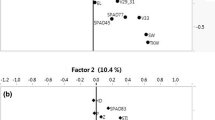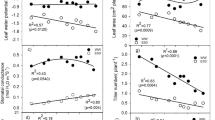Abstract
The breeding of winter wheat was carried out using conventional technology in the Rostov Federal Agrarian Research Center in 2014–2019. It took place in the chernozem (black earth) steppe under the conditions of a severely continental climate with insufficient and unstable humidity. It is demonstrated that yield stability in a wide range of environments becomes possible due to creating the environmental plasticity margin against the basic stress factors when trait values approach a limit in the region (76–88% of plants must survive with a temperature of –18°С at the tillering node, 75–82% after ice crust, 76–78% after May frosts, etc.). The selection markers under droughts, including grain weight per plant, harvest index, aboveground mass, and function of leaves in photosynthesis, have been identified. They enable one to clearly focus on populations and to reveal the required recombinants. Methods have been established to create selectable genetic variation in all breeding directions, which allows the approved program to be implemented. The breeding technology for the purpose of achieving trait transgressions has been proven. Based on the obtained results, the next-generation varieties, such as Bylina Dona, Akapella, Pafos, and Pal’mira 18, have been developed. The degree of their environmental plasticity has been determined.
Similar content being viewed by others
REFERENCES
Grabovets, A.I. and Fomenko, V.A., Some aspects of the winter wheat breeding for winter hardiness in conditions of changing climate, Russ. Agric. Sci., 2015, vol. 41, no. 1, pp. 1–4.
Saulesku N.N. and Braun, Kh.-Dzh., Cold resistance, in Primenenie fiziologii v selektsii pshenitsy (Application of Physiology in Wheat Breeding), Kiev: Logos, 2007, pp. 228–254.
Poltarev, E.M., Borisenko, L.R., and Ryabchun, N.I., Determination of the genetic potential of frost resistance of winter wheat varieties, in Urozhai i adaptivnyi potentsial ekologicheskoi sistemy (Harvest and Adaptive Potential of the Ecological System), Kiev, 1991, pp. 27–29.
Levitt, J., The hardiness of plants, Agronomy (New York), 1956, vol. 6.
Grabovets, A.I. and Fomenko, M.A., The gene pool and breeding of winter bread wheat on the Don, in FITs institut tsitologii i genetiki sibirskogo otd. RAN. Mat. IV mezhd. konferentsii “Genofond i selektsiya rastenii” (Federal Research Center of Cytology and Genetics of Siberian Branch of Russian Academy of Sciences. Proc. IV Int. Conference “Gene Pool and Plant Breeding”), Novosibirsk, 2018, pp. 97–100.
Ablova, I.B., Bespalova, L.A., Kolesnikov, F.A., Nabokov, G.D., Puzyrnaya, O.Yu., and Filobok, V.A., Wheat breeding for disease resistance, Zemledelie, 2014, no. 3, pp. 19–23.
Fomenko, M.A., Grabovets, A.I., Mel’nikova, O.V., and Oleinikova, T.A., Parameters of adaptability and homeostaticity of winter soft wheat cultivars in the steppe zone of Rostov oblast, Zernobobovye Krupyanye Kul’t., 2019, vol. 4, no. 32, pp. 27–32.
Zhuchenko, A.A., Ekologicheskaya genetika kul’turnykh rastenii kak samostoyatel’naya nauchnaya distsiplina (Ecological Genetics of Cultivated Plants as an Independent Scientific Discipline), Krasnodar: Prosveshchenie-Yug, 2010.
Boroevich, S., Printsipy i metody selektsii rastenii (Principles and Methods of Plant Breeding), Moscow: Kolos, 1984.
Levis, D., Gene-environment interaction: A relationship between dominance, heterosis, phenotypic stability and variability, Heredity, 1954, vol. 8, pp. 333–356.
Pakudin, V.Z. and Lopatina, L.M., Assessment of ecological plasticity and stability of crop varieties, S‑kh. Biol., 1984, no. 4, pp. 109–113.
Eberhart, S.A. and Russell, W.A., Stability parameters for comparing varieties, Crop Sci., 1966, no. 6, pp. 36–40.
Khangil'din, V.V. and Litvinenko, N.A., Homeostaticity and adaptability of winter wheat varieties, Nauchno.-Tekh. Sb. (Odessa), 1981, vol. 1, no. 39, p. 8.
Grabovets, A.I. and Fomenko, M.A., Ozimaya pshenitsa (Winter Wheat), Rostov-on-Don: Yug, 2007.
Grabovets, A.I., Improved methods for assessing frost and winter hardiness of plants, Sel. Semenovod., 1983, no. 2, pp. 23–26.
Richards, R.A., Kondon, A.G., and Rebetske, G.D., Traits that improve yields in drought conditions, in Primenenie fiziologii v selektsii pshenitsy (Application of Physiology in Wheat Breeding), Kiev: Logos, 2007, pp. 184–207.
Voskresenskaya, G.S. and Shpota, V.I., Transgression of traits in Brassica hybrids and the method of quantitative accounting for this phenomenon, Dokl. Akad. Nauk SSSR, 1967, no. 7, pp. 18–20.
Grabovets, A.I. and Fomenko, M.A., Plus-transgression in winter wheat breeding on frost resistance and productivity, Russ. Agric. Sci., 2019, vol. 45, no. 5, pp. 407–411.
Fait, V.I., Effects of genes controlling the duration of vernalization (Vrd) on agronomic traits in winter bread wheat, Tsitol. Genet., 2007, no. 5, pp. 18–26.
Fomenko, M.A., Breeding of winter bread wheat on the Don under conditions of increasing climate aridity, Extended Abstract of Doctoral (Agric.) Dissertation, Rostov-on-Don, 2014.
Osipov, Yu.F., Fadeeva, O.I., and Fedulov, Yu.P., Recommendations for the development of models of winter wheat varieties in the North Caucasus, in Primenenie fiziologicheskikh metodov pri otsenke selektsionnogo materiala i modelirovanii novykh sortov s.-kh kul’tur (Application of Physiological Methods in the Assessment of Breeding Material and Modeling New Varieties of Agricultural Crops), Moscow: VASKhNIL, 1983, pp. 26–31.
Author information
Authors and Affiliations
Corresponding author
Ethics declarations
The authors declare that they have no conflict of interest. This article does not contain any studies involving animals or human participants performed by any of the authors.
Additional information
Translated by N. Bogacheva
About this article
Cite this article
Grabovets, A.I., Fomenko, M.A. Yield Stability in a Wide Range of Environments as a Primary Parameter in Winter Wheat Breeding. Russ. Agricult. Sci. 46, 539–544 (2020). https://doi.org/10.3103/S1068367420060075
Received:
Accepted:
Published:
Issue Date:
DOI: https://doi.org/10.3103/S1068367420060075




